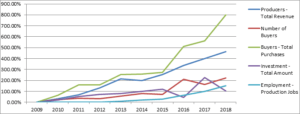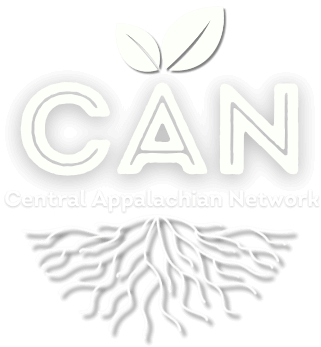A Regional Movement
Across Central Appalachia, a strong local food and ag movement has emerged, with a collaborative network of food & ag-focused funders, businesses, and nonprofit practitioners pursuing aligned strategies. Local and regional food systems are beginning to realize their potential as a means to address economic, health, and environmental goals simultaneously. Locally-rooted actors across our 6-state region are pursuing aligned strategies that grow food businesses, create jobs, conserve farmland, protect natural resources, and increase access to fresh, healthy foods.
Food & Ag Systems Working Group (FASWG)
Over the past 6 years, CAN has partnered with the Appalachia Funders Network to host a Food & Ag Systems Working Group. This working group has facilitated collaborative research, events, fundraising, and multi-stakeholder projects. The FASWG’s current focus is to leverage existing regional momentum, analysis, and expertise to solidify Appalachia’s food & ag system as an economic driver in the region. To this end, members have identified the below three critical leverage points that, if addressed, would support the profitability of local food & ag actors, offer low-income communities access to fresh food, and increase the overall resiliency of the region’s food system. To read more about the FASWG’s investment priorities, visit this page.
- Agricultural Production: Demand for local produce is growing in Central Appalachia, which presents an opportunity for more farmers to begin farming or increase production to meet that demand. Across the region, demand for fresh produce outstrips supply. Beginning farmers in particular need access to training, technical assistance, infrastructure, capital, and markets to grow into viable farm businesses. Find Beginning Farmer Programs by State on this page.
- Processing, Aggregation, and Distribution (PAD): As more farmers increase their production capacity, they must have access to the infrastructure that helps them reach larger markets. The potential for business growth, new jobs, and increased income depends on the availability and access to infrastructure for value-added processing, product aggregation, and efficient distribution.
- Food Access: Many rural communities across Appalachia exist in so-called food deserts, where residents have limited access to fresh and healthy food. In both rural and urban areas, low-income families experience high levels of food insecurity and poor dietary options that lead to hunger, obesity, diabetes, and other chronic disease. This challenge is also an opportunity, as regional actors from farmers markets to food pantries are collaborating to improve food access by connecting low-income families to fresh, healthy, local foods. Advocacy, education, and investment in food access is critical to ensuring healthy rural people and economies.
Local Food Value Chains
Thriving local food economies can support the development of diversified and resilient economic bases, increase local control of wealth, empower local individuals and communities, increase self-sufficiency and decrease dependence on government benefits, and help to protect natural resources such as soil, water, and air quality.
CAN works to develop and strengthen local food value chains, which we define as supply chains infused with the triple bottom line values of promoting financial, social, and environmental goals. Local food value chains include producers, processors, aggregators, distributors, farmers markets, wholesale buyers, consumers, and a wide variety of important supporters. In five sub-regions throughout Central Appalachia, CAN works to develop infrastructure, make connections, and build capacity to increase the profitability and sustainability of these value chains.
CAN’s member organizations, and many of our partners, act as “intermediaries” in these chains. Intermediaries:
- Connect producers to markets
- Provide and distribute educational materials
- Create and promote marketing and training tools
- Coordinate policy work
- Facilitate collaboration among value chain participants
- Some intermediary organizations also play additional roles in the value chain
Economic Impacts
CAN tracks economic impact indicators to show the growth of the local food system since 2009. The following chart shows the growth of the CAN-supported value chains according to several key measures. All measures are calculated in relation to 2009 data; that is, 2009 numbers establish the baseline, and subsequent growth for each measure is compared as a percentage increase over the 2009 number.

The total impacts for 2018 include:
- 1,608 producers or food businesses participating in CAN-affiliated value chains
- $20.1 Million in sales revenue to producers
- $16.1 Million in purchases by 164 wholesale/institutional buyers
- 1,478.5 Full time equivalent jobs, including 1,195.5 year-round positions
- $3 Million in value chain investment, including $2.1 Million from sources within the value chain
